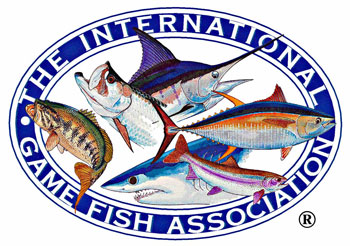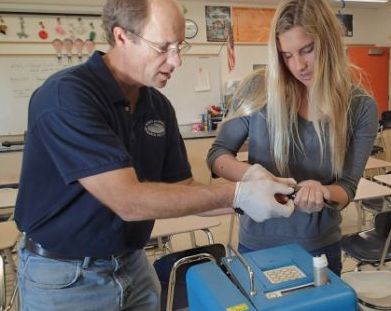|
January 22, 2014 |
 Sportsmanship and conservation go hand in hand – anglers who hope for more and bigger fish tomorrow invariably understand the need to release catches they make today. Since 1993, the International Game Fish Association (IGFA) has been recognizing superlative achievements in fishing conservation with the annual awards, bestowed upon honorees at the yearly IGFA International Auction & Banquet. This year, the organization will give Conservation Awards in three categories at the event on January 31, 2014 at their headquarters in Dania Beach, Florida, USA and Hubbs-SeaWorld Research Institute (HSWRI), has been chosen to receive the Organizational Award.HSWRI, an independent non-profit 501(c)(3) organization in southern California USA, officially celebrated 50 years of its mission “to return to the sea some measure of the benefits derived from it” on June 3, 2013. Two months later, in August, HSWRI released its Two Millionth white seabass – a testament to the success of their vision and the support of the California recreational angling community. The Two Millionth tagged white seabass, produced by the Ocean Resources Enhancement and Hatchery Program (OREHP), was released into the coastal waters of southern California, along with about 300 of its siblings, from the Institute’s Mission Bay offices by event Honorary Chair, Paxson Offield and HSWRI’s President/CEO, Don Kent. According to Mr. Kent, “The release of the Two Millionth tagged white seabass marks a second extraordinary milestone for the Program. Because the white seabass population was so severely depleted , it is critical to use the most responsible and environmentally sound practices to rebuild them, and the Ocean Resources Enhancement and Hatchery Program does just that.” Sportsmanship and conservation go hand in hand – anglers who hope for more and bigger fish tomorrow invariably understand the need to release catches they make today. Since 1993, the International Game Fish Association (IGFA) has been recognizing superlative achievements in fishing conservation with the annual awards, bestowed upon honorees at the yearly IGFA International Auction & Banquet. This year, the organization will give Conservation Awards in three categories at the event on January 31, 2014 at their headquarters in Dania Beach, Florida, USA and Hubbs-SeaWorld Research Institute (HSWRI), has been chosen to receive the Organizational Award.HSWRI, an independent non-profit 501(c)(3) organization in southern California USA, officially celebrated 50 years of its mission “to return to the sea some measure of the benefits derived from it” on June 3, 2013. Two months later, in August, HSWRI released its Two Millionth white seabass – a testament to the success of their vision and the support of the California recreational angling community. The Two Millionth tagged white seabass, produced by the Ocean Resources Enhancement and Hatchery Program (OREHP), was released into the coastal waters of southern California, along with about 300 of its siblings, from the Institute’s Mission Bay offices by event Honorary Chair, Paxson Offield and HSWRI’s President/CEO, Don Kent. According to Mr. Kent, “The release of the Two Millionth tagged white seabass marks a second extraordinary milestone for the Program. Because the white seabass population was so severely depleted , it is critical to use the most responsible and environmentally sound practices to rebuild them, and the Ocean Resources Enhancement and Hatchery Program does just that.”
OREHP is a proactive conservation research program that is a unique partnership between the California Department of Fish and Wildlife, public utility companies, volunteer sport fishing groups and the scientific community. The collaboration has enabled the white seabass program to benefit the California fishing community and the state’s resource management agency by providing an effective tool for sustaining and recovering depleted stocks. The program is one of the nation’s largest marine fish enhancement programs, the only program of its kind on the west coast of North America, and one of the few stocking programs that assesses the biological and economic impacts of its releases. Bill Shedd, son of Milt Shedd and current HSWRI Board Chair, stated that, “We are ecstatic at not only reaching this important Two Millionth fish release milestone, but also about the incredible impact it is having on rebounding white seabass populations, a true sea life solution. The Institute accepts this award on behalf of southern California sportfishermen and women and sport fishing groups who initially proposed the Ocean Enhancement Stamp – the proceeds from which continue to support the general operating of the Institute’s hatchery program today.” The recreational fishing community has been critically important in restoring the white seabass population and recreational fishing contributes over $2 billion annually to the California economy. Under the umbrella of the United Anglers of Southern California, the sport fishing industry contributes over 20,000 volunteer hours annually to the OREHP Program, helping grow the seabass to a larger size at as many as 12 different cage growout facilities along the California tline. Cage systems allow the seabass fingerlings to be reared at sea to a larger size, which dramatically increases the potential for fish survival after release. One of the OREHP’s largest cage systems is also used to temporarily hold broodstock and this facility has been underwritten by philanthropist and sportfisherman Paxson Offield, Chairman of the Catalina Seabass Fund for the past decade. – more – HUBBS-SEAWORLD RESEARCH INSTITUTE TO CELEBRATE MILESTONE The Leon Raymond Hubbard, Jr. Marine Fish Hatchery was dedicated in 1995 and is capable of producing more than 350,000 juvenile white seabass annually. The 22,000-square-foot hatchery was built on land initially donated by San Diego Gas & Electric that is now owned by NRG Energy, Inc. which continues to support the program through the use of the property. The hatchery is adjacent to Agua Hedionda Lagoon in Carlsbad, California. HSWRI is a nonprofit research foundation established in 1963, dedicated to studying the world’s natural resources, with an emphasis finding sea life solutions to mitigate human impacts on marine and coastal environments. Through a commitment to innovative scientific research, the Institute contributes to the understanding and conservation of the marine world. For more information: www.hswri.org Founded in 1939, the IGFA is a non-profit organized under Section 501(c)(3) under the Internal Revenue Code and is best known for conservation efforts of fisheries, educational programs, rule-making and for maintaining worldwide game fish records in freshwater, saltwater, fly fishing and junior angler categories. IGFA members are located in over 125 countries. The IGFA welcomes visitors to its 60,000-square-foot interactive Fishing Hall of Fame & Museum in Dania Beach, Florida. For further information, contact the IGFA Fishing Hall of Fame & Museum, 300 Gulf Stream Way, Dania Beach, Florida 33004; phone 954-927-2628, fax: 954-924-4299, website: www.igfa.org. ##hswri## |
|
November 15, 2013 |
H.B. High students contribute to replenishing ocean’s white seabass
Hubbs-SeaWorld Research Institute research scientist Mike Shane and Huntington Beach High School student Samantha Cendro work in the school’s lab specially designed to raise white seabass. PHOTO COURTESY OF NANCY CARUSO
By ANNIE ZAK / ORANGE COUNTY REGISTER There aren’t many marine organisms that humans can grow in a controlled environment and then release into the ocean. But students at Huntington Beach High School are part of a program doing just that with white seabass. By partnering with Hubbs-SeaWorld Research Institute and an ocean restoration nonprofit called Get Inspired! Inc., students in an AP environmental science class are able to raise the fish from when they’re just three inches long until they’re ready to be released into the ocean. Keeping the fish alive is complicated, and it’s entirely up to the students. Nancy Caruso, founder of Get Inspired! Inc., said that the students get attached and are successful in maintaining the operation, but they care so much about the fish that when there is a tragedy such as a fish death, students cry. “I make them very aware that we are all this animal has,” said Caruso. “They’re scared to death to do something wrong.” This is Caruso’s goal: To create a connection so strong between the seabass and the students that by the time students release the fish, they’ve gained not only knowledge about an ecosystem, but a passion for being stewards of the ocean. Keeping the fish alive is more than just feeding them daily; students, with the help of teachers, Caruso and Mike Shane, a research scientist at Hubbs-SeaWorld, built the entire operation. That includes making the salt water themselves. Students are responsible for ensuring the tank’s pump system is operating correctly, checking pH levels and cleaning the tank daily, among other meticulous measurements and tasks. The tank system at Huntington Beach High School had a one-time cost of $10,000 to build, plus $3,000 to make all the sea water, all paid for with grant money. Now, the system costs about $1500 annually to run. Caruso said her organization recently received a grant to put another white seabass tank in Warner Middle School, though it will be smaller than the high school’s. For the past two years, the school has released about 35 fish annually, in two batches, into the ocean. This year’s second release will come at the end of November. White seabass raised in the classroom contribute to a much larger effort by Hubbs-SeaWorld, which has replenished over two million of the fish into the ocean since the start of their efforts in the late 1980s. Shane said while one side of the program teaches students about the importance of marine life, it also provides STEM (science, technology, engineering and math) education training that will help them get hired in the future. “They’ll have skill sets and jobs that can help them get jobs in aquaculture,” said Shane. The students also get to tour the Hubbs-SeaWorld fish hatchery in Carlsbad, which provides the fish to the high school. Hubbs-SeaWorld has been making the effort to grow white seabass ever since the late 1980s, when there was a sharp decline in the number of the species in the ocean, said Caruso. Last week, Shane returned to the high school to tag the fish, each with a unique metallic thread in its head. The tags include unique tracking numbers that will help students see where their fish end up years down the line if they’re caught by fishermen. “If kids don’t go on that journey, they don’t build that attachment,” said Caruso. Contact the writer: azak@ocregister.com or 714-796-7845 |

